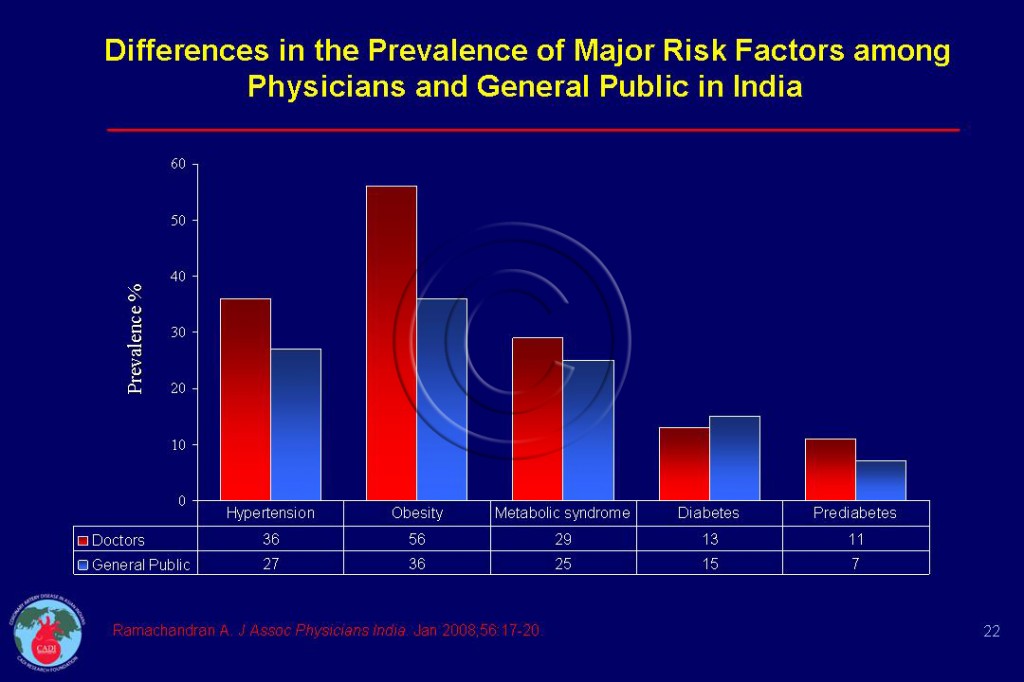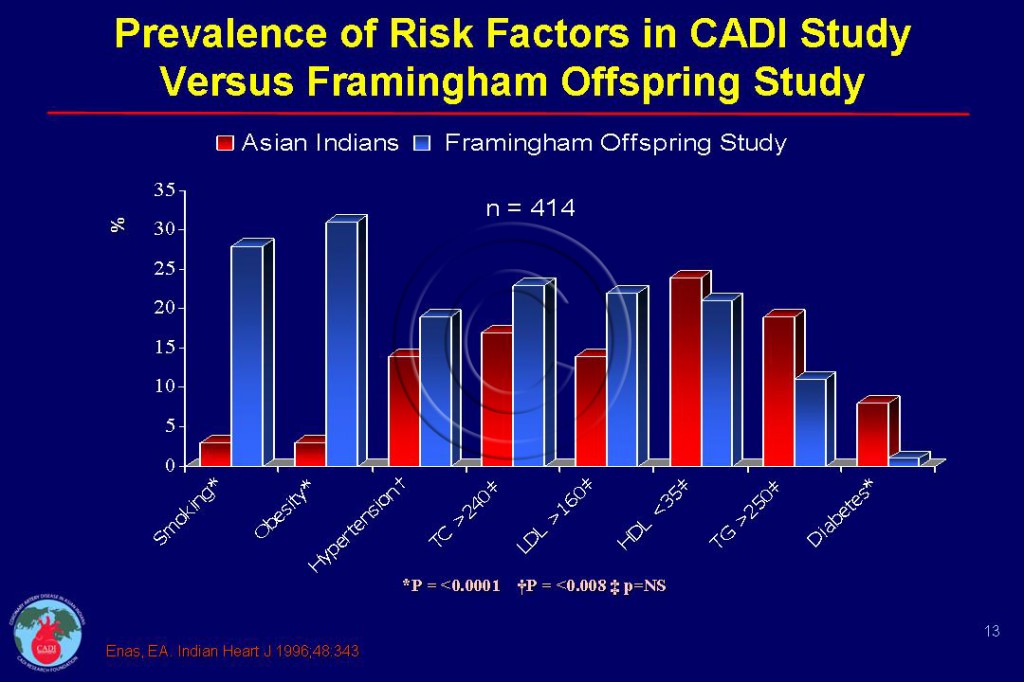Physician Heal Thyself
- Physicians in India have high prevalence of cardiovascular disease (CVD) risk factors. This is very disturbing and is in sharp contrast to very low prevalence of risk factors among Indian and non-Indian physicians in the US.1-3
- Since today’s risk factors are tomorrow’s disease, many of these physicians in India are likely to be swept away by the tsunami of heart disease, unless preventive measures are urgently undertaken.
- A study of 2499 doctors in South India showed a significantly higher prevalence of all CVD risk factors except diabetes, compared with the general population as shown in Figure 022. 3
- Undetected cases of diabetes and high blood pressure were equally high in both groups. Use of alcohol was more common among doctors. Only 17% of the physicians in India are physically active and 31% of male physicians are smokers.
- The Physicians’ Health Study (in the US) has reported a substantially lower prevalence of coronary artery disease (CAD) and its risk factors among US physicians compared to the general population. For example, smoking rate was only 8% and obesity rate was only 14%.2 No wonder CAD mortality among the US physicians has decreased by more than 80% compared to 70% in the general population in the US.4
- The Coronary Artery Disease among Asian Indians (CADI) Study has reported a very low prevalence of risk factors among the US-Based Asian Indian physicians ─lower than that reported from the Physicians Health Study.2 The age-adjusted prevalence of several key risk factors were as follows: smoking 1%, obesity 4%, diabetes 8%, and hypertension 14% (Figure 013).2
- The US-based Asian Indian physicians were physically active with 70% engaging in leisure-time physical activity which averaged 136 minutes/week─ more than double the 60 minutes per week recommended at that time.5
- They also consumed a diet low in saturated fat (8% of the calories).5 As a result, the Asian Indian physicians in the US had a lipid profile similar to those of Americans from the Framingham Offspring Study (used for comparison with the US general population).2
- Despite having a better risk factor profile than the American public and American physicians, the US-based Asian Indian physicians had an age-adjusted CAD prevalence of 10 %, which was 4 times higher than that reported from the Framingham Offspring Study. Prevalence data for CAD was not available for comparison with the US physicians.2
- The risk factor profile of the Indian physicians in the US was substantially better than that of their patients, yet they had a 4-fold higher rate of heart disease. One can only wonder, the CVD burden of physicians in India who have not bothered to modify their lifestyle and carry a very high risk factor burden.
- The CADI Study data clearly demonstrates that the risk factor profile can be substantially reduced with proper education of Asian Indian physicians, who in turn can educate their patients about the necessity of achieving and maintaining a low risk factor profile.6
- The high prevalence of modifiable risk factors among those who are responsible for championing CVD prevention in India is indeed alarming, given the genetic susceptibly of this population.
- Given the genetic susceptibility mediated through lipoprotein(a) the adverse effect of all modifiable risk factors are magnified in a multiplicative way and underscore the need for reducing the risk factors to its optimal levels.1
- Doctors must practice what they preach to their patients, especially healthful lifestyle and habits. There is an urgent need to intensify the education of Indian physicians to stem the Tsunami of heart disease in India.7
Sources
1. Ramachandran A, Mary S, Yamuna A, Murugesan N, Snehalatha C. High prevalence of diabetes and cardiovascular risk factors associated with urbanization in India. Diabetes Care. May 2008;31(5):893-898.
2. Enas EA, Garg A, Davidson MA, Nair VM, Huet BA, Yusuf S. Coronary heart disease and its risk factors in first-generation immigrant Asian Indians to the United States of America. Indian Heart J. Jul-Aug 1996;48(4):343-353.
3. Ramachandran A, Snehalatha C, Yamuna A, Murugesan N. High prevalence of cardiometabolic risk factors among young physicians in India. J Assoc Physicians India. Jan 2008;56:17-20.
4. Enas EA. Alcohol and cardiovascular mortality in US physicians – is there a modifier effect by low density lipoprotein? Arch Intern Med. 1997;157:1769-1770.
5. Yagalla MV, Hoerr SL, Song WO, Enas E, Garg A. Relationship of diet, abdominal obesity, and physical activity to plasma lipoprotein levels in Asian Indian physicians residing in the United States. J Am Diet Assoc. 1996;96(3):257-261.
6. Lloyd-Jones D. M., Hong Y, Labarthe D, et al. Defining and setting national goals for cardiovascular health promotion and disease reduction: the American Heart Association’s strategic Impact Goal through 2020 and beyond. Circulation. Feb 2 2010;121(4):586-613.
7. Enas EA. How to Beat the Heart Disease Epidemic among South Asians: A Prevention and Management Guide for Asian Indians and their Doctors. Downers Grove: Advanced Heart Lipid Clinic USA; 2010.



